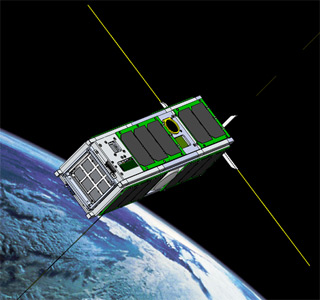Thank you very much for visiting Gunter's Space Page. I hope that this site is useful and informative for you.
If you appreciate the information provided on this site, please consider supporting my work by making a simple and secure donation via PayPal. Please help to run the website and keep everything free of charge. Thank you very much.
ARMADILLO

ARMADILLO [University of Texas]
ARMADILLO (Attitude Related Maneuvers and Debris Instrumentation in Low (L) Orbit) is a three unit CubeSat that is being designed and built by students at the University of Texas at Austin (UT-Austin) in collaboration with Baylor University.
ARMADILLO will study and characterize sub-millimeter space debris particles currently in Low Earth Orbit (LEO) using a Piezo Dust Detector (PDD) developed at the Center for Astrophysics, Space Physics and Engineering Research (CASPER) at Baylor University. Additionally, the spacecraft will obtain radio occultation measurements by collecting GPS measurements using a dual frequency, software-defined FOTON GPS receiver developed by the Radionavigation Lab at UT-Austin. In order to precisely point the PDD and FOTON GPS Receiver, so as to obtain the best scientific results, the ARMADILLO picosatellite will have a precise six degree-of-freedom attitude control system. The satellite will also establish optical navigation and provide an independent verification of the ADC unit with an in-house developed star tracker, as well as have the capability to reprogram the on-board computer while in orbit.
The ARMADILLO mission has three primary mission objectives – two are related to the on-board scientific payload while the third is related to the systems engineering of the spacecraft. These mission objectives are:
- Characterize in-situ sub-millimeter level dust and debris particles in LEO by sensing impacts at varying times, directions and locations
- Demonstrate ionospheric radio-occultation within a single CubeSat volume (10 cm × 10 cm × 10 cm) using a software-defined dual frequency GPS receiver
- Train students in best systems engineering practices by executing a complete spacecraft life cycle from concept design to mission operations
It was launched on the ELaNa-15 mission.
| Nation: | USA |
|---|---|
| Type / Application: | Technology |
| Operator: | University of Texas |
| Contractors: | University of Texas |
| Equipment: | |
| Configuration: | CubeSat (3U) |
| Propulsion: | |
| Power: | Solar cells, batteries |
| Lifetime: | |
| Mass: | 4 kg |
| Orbit: | 305 km × 851 km, 28.54° |
| Satellite | COSPAR | Date | LS | Launch Vehicle | Remarks | |
|---|---|---|---|---|---|---|
| ARMADILLO | 2019-036P | 25.06.2019 | CCK LC-39A | Falcon-Heavy (Block 5) | with DSX , FORMOSAT 7A, 7B, 7C, 7D, 7E, 7F, GPIM, OTB 1, NPSat 1, Oculus-ASR, Prox 1, LightSail 2, FalconSat 7, E-TBEx A, E-TBEx B, PSat 2, BRICSat 2, Prometheus 2.6, Prometheus Mass Model, TEPCE 1, 2, CP 9 (LEO), StangSat |
References:
- University of Texas: ARMADILLO Team Website
- Emerald (Nanosat 1)
- Orion (Nanosat 1)
- Constellation Pathfinder (Nanosat 1)
- Solar Blade (Nanosat 1)
- 3CSat 1, 2, 3 (Nanosat 2)
- ION-F (Nanosat 2)
- FASTRAC 1, 2 (Nanosat 3)
- CUSat 1, 2 (Nanosat 4)
- DANDE (Nanosat 5)
- Oculus-ASR (Nanosat 6)
- Violet (Nanosat 6)
- Ho‘oponopono 2 (Nanosat 6)
- COPPER (Nanosat 6).
- Prox 1 (Nanosat 7)
- ARMADILLO (Nanosat 7)
- Argus (Nanosat 7)
- M-Sat (Nanosat 8)
- PolarCube (Nanosat 8)
- RECONSO
- ELEOsat
- ANDESITE (Nanosat 8)
- GLADOS (Nanosat 8)
- CHOMPTT (Nanosat 8).
- Maxwell (Nanosat 9)
- MOCI (Nanosat 9)
- EXACT (Nanosat 10)
- Aggiesat 6 (Nanosat 10)
- Auris (Nanosat 10)
